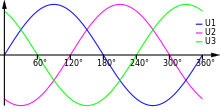Neutral current
The neutral conductor current is a term from electrical engineering . A three-phase connection in low-voltage networks consists of three outer conductors and the neutral conductor . This three-phase connection is either used directly (e.g. for larger consumers such as the stove or the instantaneous water heater in the home ), or the consumers are divided between the three outer conductors. These provide then with one phase conductor and the neutral conductor 230 V individual consumers with AC voltage .
The total current of the three external conductors flows through the neutral conductor to the neutral point of the local transformer station . The sum results from the instantaneous values of the currents shifted by 120 ° in the phase angle . With symmetrical loading of the three outer conductors by linear consumers (these are consumers that do not generate any harmonics in the current), the amount of the current in the neutral conductor is zero. With linear consumers, the neutral conductor only absorbs the total current that is caused by the uneven loading of the three outer conductors. The total current can therefore accept a maximum of the largest single conductor current (and not approximately three times an individual current). The cross-section of the neutral conductor can therefore be reduced in certain situations or, in extreme cases, if symmetrical loading of the outer conductor is guaranteed, it can even be omitted entirely.
The picture shows the three-phase transformer as an energy source on the left and the star connection as a three-phase consumer on the right. The current through the neutral conductor results from the sum of the three external conductor currents in the case of a harmonic course and is zero in the symmetrical case:
Load on the neutral conductor
Today there are many consumers with electronic items such as B. televisions, computers, chargers for various small devices, lights with electronic ballasts , electronically controlled drives, etc., which are mainly equipped with capacitively smoothed power supplies. Most of these power supplies work without an input transformer or series inductance and, for smaller outputs, without power factor correction. The storage capacitors are charged in a very short time with a high current pulse. The resulting current curve deviates markedly from the sinusoidal curve and generates harmonics that lead to non-harmonic alternating currents.
Harmonics superimpose the basic oscillation (mains frequency = 50 Hz) with an integer multiple of the basic oscillation frequency. The odd harmonics , divisible by 3 , in particular the dominant 3rd harmonic, followed by the 9th and 15th harmonic, add up in the neutral conductor . Higher harmonics do not matter. In total, this can lead to high currents in the neutral conductor, which do not cancel each other out even with an exact symmetrical load distribution. Measurements have shown that the neutral conductor current can rise to over 100% of the phase conductor current.
When designing new systems, the rules of technology according to DIN VDE 0100-520: 2003-06 section 524 must be followed. The neutral conductor, if present, must not have a smaller cross-section than the outer conductor (for exceptions and conditions see this VDE). A new addition as DIN VDE 0100-520 supplement 3: 2012-10 takes account of the fact that the network is loaded with harmonics and recommends adapted values for the current load of cables and lines in 3 columns for different proportions of harmonics in the external conductor current for <15 to 30 %,> 33 to 45% and> 45% (calculated with 60%).
According to a recommendation by the ZVEI, an analysis of the intended consumers and their effects should also be carried out with regard to harmonics on the neutral conductor load and the dimensioning of the cables, lines and busbar systems should take into account the determined neutral conductor load.
See also
Individual evidence
- ↑ Dimensioning of neutral conductors in switchgear. (PDF) ZVEI, accessed on March 26, 2012 .





